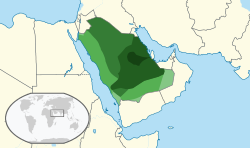Third Saudi State
This article has multiple issues. Please help improve it or discuss these issues on the talk page. (Learn how and when to remove these messages)
|
Third Saudi State الدولة السعودية الثالثة (Arabic) | |||||||||||
|---|---|---|---|---|---|---|---|---|---|---|---|
 Map of the countries that established the third Saudi state
| |||||||||||
| Capital | Riyadh | ||||||||||
| Common languages | Arabic | ||||||||||
| Religion | Sunni Islam | ||||||||||
| Government | Absolute monarchy | ||||||||||
| |||||||||||
The Third Saudi state is the heir to the two earlier Saudi states: the first and the second, founded by Abdul Aziz bin Abdul Rahman (also known as "Ibn Saud"), who managed to capture the city of Riyadh on January 13, 1902. A long series of conflicts and conquests ultimately led to the establishment of the modern and contemporary Saudi state, the Kingdom of Saudi Arabia.
History
[edit]The third Saudi state was known at the beginning of its reign as "the Emirate of Riyadh" (1902–1913) and "the Emirate of Nejd and Hasa" (1913–1921). After the overthrow of the rival Emirate of Ha'il gave the Emirate of Najd and Al-Ahsa control of the entire Nejd region, it became known as the Sultanate of Nejd. Abdul Aziz conquered the Kingdom of Hejaz in 1925. He raised Nejd to a kingdom in 1927, and his dominions became known as the Kingdom of Hejaz and Nejd and its annexes. Abdul Aziz administered the two portions of his dual kingdom separately until the annexation of the Southern Territory and the announcement of the establishment of the Kingdom of Saudi Arabia in 1932.[1]
See also
[edit]- History of Saudi Arabia
- Unification of Saudi Arabia
- Sheikhdom of Diriyah
- Emirate of Diriyah
- Emirate of Nejd
- Emirate of Nejd and Hasa
- Emirate of Jabal Shammar
- Sultanate of Nejd
- Kingdom of Hejaz
- Kingdom of Hejaz and Nejd
References
[edit]- ^ Madawi Al-Rasheed. A History of Saudi Arabia. Cambridge, England, UK: Cambridge University Press, 2002. Pp. 40.
External links
[edit]

